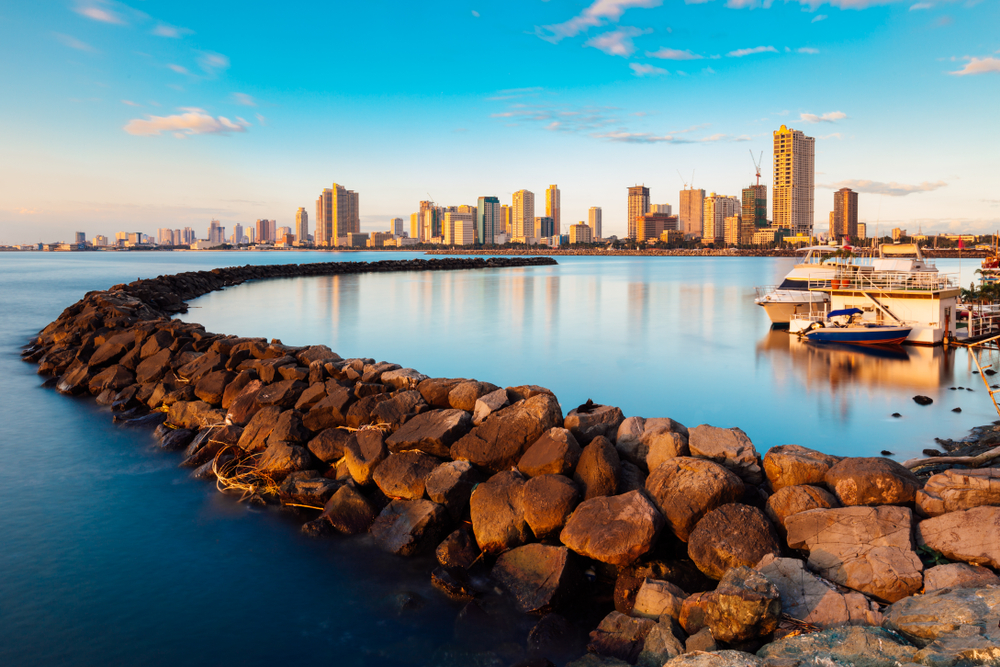

Travel information Philippines
| Capital | Manila |
|---|---|
| Form of government | : Republic, presidential democracy |
| Currency | Philippine Peso (PHP) |
| Area | approx. 343,448 km² |
| Population | 106,512,000 (2018) |
| Languages | Filipino (national and official), English (official) |
| Power supply | 220 volts, 60 Hz |
| Calling code | +63 |
| Time zone | UTC+8 |
Important telephone numbers
- Emergency number (police, fire brigade, ambulance): 911
- Police: 117
- German Embassy in Manila: +63 2 8702 3000
- Tourist Police (Manila): +63 2 524 1660
German Doctors
- Dr. Wolfgang Oertel: Makati Medical Center, +63 2 8888 8999
- Dr. Hans Peter Reiss: St. Luke’s Medical Center, +63 2 789 7700
The most important words with translation
- Hello – Kumusta
- Thank you – Salamat
- Please – Pakiusap
- Yes – Oo
- No – Hindi
- Sorry – Paumanhin
- Where is…? – Saan ang…?
- How much does it cost…? – Magkano ito?
- Emergency – Emergency
- Doctor – Doctor
- Hospital – Ospital
Holidays
- New Year’s Day: January 1
- Good Friday: variable (March/April)
- Easter Monday: variable (March/April)
- Labour Day: 1 May
- Independence Day: June 12
- National Heroes’ Day: last Monday in August
- All Saints’ Day: November 1
- Bonifacio Day: November 30
- Christmas: December 25
- Rizal Day: December 30
Opening hours
- Shops: Usually Monday to Sunday from 10:00 to 21:00.
- Supermarkets: Usually daily from 8:00 a.m. to 10:00 p.m.
- Restaurants: Lunch from 11:00 to 14:00, dinner from 18:00 to 22:00.
- Banks: Monday to Friday from 9:00 a.m. to 4:00 p.m.
Airport
- Ninoy Aquino International Airport (MNL): The main airport in Manila, the largest airport in the country.
- Mactan-Cebu International Airport (CEB): The second busiest airport in the Philippines.
- Clark International Airport (CRK): Near Angeles City, about 80 km northwest of Manila.
NUDISM
- Not allowed: Nudism is not common in the Philippines and is considered offensive.
There are no official nudist beaches.
Post / Stamps
- Post offices: In all major cities and towns. Main post office in Manila. Opening hours: Monday to Friday from 8:00 a.m. to 5:00 p.m.
- Stamps: Available at the post office and in some kiosks and supermarkets.
- Costs for letters and postcards to Germany: Standard letter up to 20g: approx. 40 PHP (approx. 0.70 EUR); Postcard: approx. 30 PHP (approx. 0.50 EUR)
Safety
- Crime: The Philippines is a popular tourist destination, but there are some areas that are considered unsafe.
It is advisable to check current travel advice and observe common precautions, especially in larger cities and tourist areas. - Emergency number: 911
Current
- Voltage: 220 Volts
- Sockets: Type A, B and C (adapters for European plugs are necessary)
Tip
- Restaurants: 10% of the bill amount is customary if a service charge is not included.
- Taxis: Round up the amount
- Hotels: PHP 20-50 per day for cleaning staff
Customs
- Allowances: Personal belongings are duty-free.
- Alcohol: Travellers are allowed to carry 2 litres of spirits or wine.
- Tobacco: 400 cigarettes or 50 cigars or 250g of tobacco.
- Other items: Goods with a total value of up to PHP 10,000 (approx. EUR 170) duty-free.


